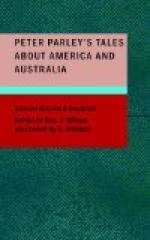“O execrable crime! so to aspire
Above our brethren, to ourselves assuming
Authority usurped from God, not given.
He gave us only over beast, fish, fowl,
Dominion absolute; that right we hold
By his donation: but man over man
He made not lord—such title
to himself
Reserving, human left from human free.”
I may now tell you something about some of the chief cities in the United States.
New York is the principal seaport and commercial metropolis of the States. It is situated at the southern extremity of an island called Manhattan Island, near the mouth of the Hudson river. Its progress has been very rapid, and its population is more than double that of any other city in the new world. The approach to the city is very fine—the shores of the bay being wooded down to the water’s edge, and thickly studded with farms, villages, and country seats. New York measures about ten miles round. It is triangular in form. The principal street is Broadway, a spacious thoroughfare extending in a straight line through the centre of the city. The houses have a clean, fresh, cheerful appearance; many of the stores or shops are highly decorated; the public buildings, including the churches, while they can make no pretension to grandeur, are good of their kind; the university is probably the finest building in the city. The hotels in New York are far more extensive than anything of the kind in Europe, and they are fitted up and conducted on a scale of princely grandeur. The city of New York was founded by the Dutch in 1621, and called New Amsterdam; but it was given to the Duke of York (afterwards James II.) in 1604, and was henceforth called by his name. The first congress of the United States was held there in 1789.
Washington is the government capital of the States, and is so called in honour of the distinguished man—the father of the Republic—to whom I have already alluded. The entrance to the city by the Pennsylvanian avenue is 100 feet wide, and planted with some of the trees. The president’s residence is called the “White House.” The chief public offices and halls for the assembly of congress are contained in one building known as the Capitol. It stands on a hill, and is said to be the finest building in the Union. It is surrounded by ornamental grounds, and overlooks the river Potomac.
Boston is a maritime city, and a great place of trade; it is situated on an extensive bay, and is connected with the interior of the country by canals, railways, and river navigation. It is the great seat of the American ice trade. In the history of the war of independence it occupies a conspicuous place, as the Bostonians displayed great energy in asserting popular rights. At Boston, when the “taxed tea” was sent over by the British government, a number of the citizens disguised themselves as Mohawk Indians, boarded the ships in which it had been brought over, seized upon and staved the chests, and threw their contents into the sea. This affair was known as the Boston tea party. Boston is the birth-place of Dr. Benjamin Franklin—the “Poor Richard” of whom I have no doubt you have often heard, and whose excellent advice cannot be too well remembered nor too carefully applied.




